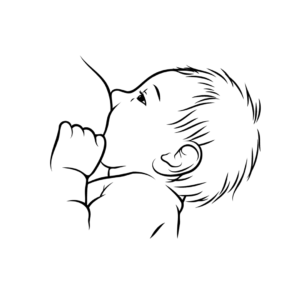If breastfeeding is your goal, what can you do to get ready for breastfeeding ahead of time? What actually works?

So you’ve made the decision to breastfeed! But with statistics showing that 60% of mothers don’t breastfeed as long as they wanted to, what can you realistically do to get ready for breastfeeding ahead of time? Is it even possible?
The answer is that while it isn’t possible to predict exactly how your breastfeeding journey will go, you can give yourself a solid foundation to success in your first breastfeeding relationship.
But not in the way that you think!
I won’t be telling you what supplies to get. The most solid way to get ready for breastfeeding is to learn what makes up the key components and the biology behind them.
Let’s get into it!
Why do women stop breastfeeding?
According to this data analysis, women who stopped breastfeeding before they originally wanted to listed these four causes:
- Latching issues
- Concerns about baby’s weight gain
- Sickness or needing to take medication
- Effort it took to maintain pumping
Information from the CDC adds these three reasons:
- Against cultural norms
- Lack of support at the hospital, workplace, and home
- Lack of adequate parental leave
Breastfeeding, while natural, doesn’t always come naturally. It’s a unique, personal experience that involves skill, knowledge, and support in order to be successful.
Whether your breastfeeding goal is 6 months, 12 months, or 2 years, being prepared in these key areas will give you the best foundation for success.
Understanding the latch
The number one reason that women stop breastfeeding is latching issues.
It’s understandable- if the latch is incorrect, baby won’t be getting enough milk and you will be in a lot of pain. And nobody wants to be in pain 8-12 times a day.
So let’s talk about what a correct latch will look like.
The biggest misconception when it comes to breastfeeding is that you will be putting baby straight onto your breast, where they will suck from only your nipple. In reality, your baby will need a much larger portion of your breast in their mouth to suckle milk out successfully. In order to get a good latch, their head will need to be angled upward when coming to latch, with their chin pushed into the underside of your breast and your nipple pointing towards the roof of their mouth. (Nose-to-nipple is another helpful saying to remember! You want their nose to be evenly in line with your nipple when coming to latch.)
Ideally, your nipple will end up compressed by the back 1/3 of their palate (roof of their mouth). This portion of their palate is soft and will protect your nipple, while the front part of their palate is hard and can cause bruising and bleeding of the nipple when compressed.
When baby is latched on correctly, it will look something like this:

The reason your infant needs to have a larger chunk of your breast is because milk is drawn out by the compression of your breast, not your nipple!
When your baby has a good latch, you will see:
- Their head is angled slightly upward
- Their mouth is open wide, with their lips almost in a straight line
- Their mouth is covering most of your areola (dark circle around your nipple)
(Click here to check out my post on how to get a good latch!)
Knowing about milk production
When it comes to milk production, it’s very rare that a woman will have a condition that physically doesn’t allow her to make enough milk. It can happen– but it’s rare.
Women will begin to produce milk around week 16 of pregnancy. Contrary to what you might have heard, you don’t need to pump before birth to make sure you’ll have enough milk. Babies have tiny stomachs when they’re born, and will only need colostrum (first milk) for the first two days. Around days 2 or 3, the “mature milk” will come in. This milk works entirely on a supply-and-demand basis- the more that’s taken out, the more your body will make!
How often a baby will need to feed depends on each individual. The average number of feedings for a newborn is 8-12 per day, or every 2-3 hours.
There will be times where your baby wants to feed more frequently, and seems fussier in between feedings. This doesn’t mean that you’ve stopped making enough milk (though always check with a lactation consultant if you’re worried)! It usually means baby is going through a growth spurt and is doing something called “cluster feeding”. This increases milk output to satisfy their new needs.
Breast size does not affect milk production. It may affect how often you need to breastfeed, as larger breasts can hold more milk at one time than smaller breasts. But your body always makes more milk to replace what is taken out!
What about weight gain?
Because you can’t physically see how much milk your baby is getting, it’s easy to get concerned. Weight gain or loss can easily affect how you view breastfeeding.
Breastfeeding babies will gain weight at a different rate than formula-feeding babies do. (On average, their overall weight gain will be less.)
It’s normal for babies to lose weight right after birth. Typically, they lose 5-7% of their birth weight in the first week. If they lose 10% or more, that’s an indication that something is wrong.
After the initial weight loss, breastfed babies go on to gain an average of 5.5oz to 8.5oz a week through the first 4 months.
Finding your support
As you get ready for breastfeeding, the most important preparation (and key to success) is finding a strong support system.
Breastfeeding can be not only physically, but emotionally taxing. You may encounter challenges you don’t know how to solve on your own. And internet searches can be hit-or-miss.
Support at all stages of breastfeeding is invaluable. Understanding the process of breastfeeding will help you, but when things get difficult, you need to know where you can turn.
Ideally, you’ll want to find both physical and social support. If you can’t find both, having even one can make all the difference in a difficult moment.
Social support looks like your partner, friends, and family. These are the people who are in your corner, who will cheer you on and be there for you. They will be wholeheartedly in support of your breastfeeding choice and work to support you in that- not minimize your choice or undermine your preferences. Social support can also look like local or online moms’ groups- those who are in the same stage of life as you and understand what it’s like.
Physical support will look like the professionals who can help you if breastfeeding isn’t going according to plan. Lactation counselors and doulas can help troubleshoot basic latching problems, and an IBCLC can help with all breastfeeding problems (including checking for tongue and lip ties).
La Leche League is a great place to find both physical and social support! They offer moms’ groups and LLL Leaders can help with basic latching problems.
Understanding potential obstacles
As you get ready for breastfeeding, it’s important to have some understanding of the potential difficulties and roadblocks you might face.
As we’ve mentioned above, breastfeeding is a natural design that doesn’t always come naturally.
There are plenty of things you might encounter on your breastfeeding journey.
These might cause setbacks or even cause you to want to quit.
Potential obstacles to a good latch include:
- Tongue tie
- Lip tie
- Inverted nipples
- Premature baby
Difficulties you can encounter during your breastfeeding journey include:
Breastfeeding for the first time can be a huge learning curve for both you and your baby. But even if it isn’t your first time, breastfeeding experiences can differ from baby to baby. If you are aware of potential roadblocks ahead of time and have a support system in place to help you overcome them, your chances of success are much higher!
How to check for flat or inverted nipples
In the paragraph above, we talked about inverted nipples as a potential roadblock to breastfeeding. Inverted nipples can prevent your baby from getting a good latch because they will not draw out and allow the milk to flow freely. While breastfeeding with inverted nipples is absolutely possible, it can be more difficult. But how can you tell whether your nipples are truly truly inverted or simply flat?
While you should always speak with an IBCLC to verify whether your nipples are truly inverted or not, there is a simple test that can point to the answer. Both flat and inverted nipples remain flat at resting phase (i.e., they don’t protrude from the breast). But doing things that would normally stimulate the nipple- such as exposure to cold or touch- will cause a flat nipple to protrude slightly. Exposure to the same stimulation will actually cause an inverted nipple to retract inwards.
If you suspect you have inverted nipples, talk to an IBCLC. They will have amazing tips and advice for how you can best breastfeed your baby!
Recap: getting ready for breastfeeding
When it comes to getting ready for breastfeeding, the most important things aren’t the items you have, but rather the knowledge and support you have. To be truly ready for breastfeeding, you’ll want a strong foundation in these 4 areas:
- Learning how to latch
- Understanding milk flow and weight gain
- Identifying potential roadblocks
- Finding a lactation consultant and other support systems
If you are solidly prepared in these 4 elements of breastfeeding, you’ll be on your way to a successful breastfeeding journey!

